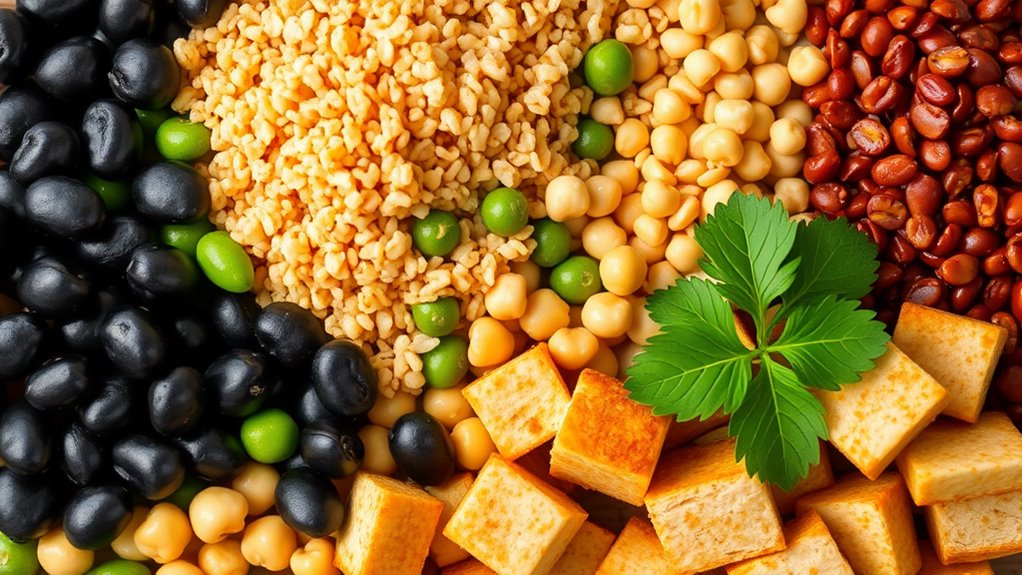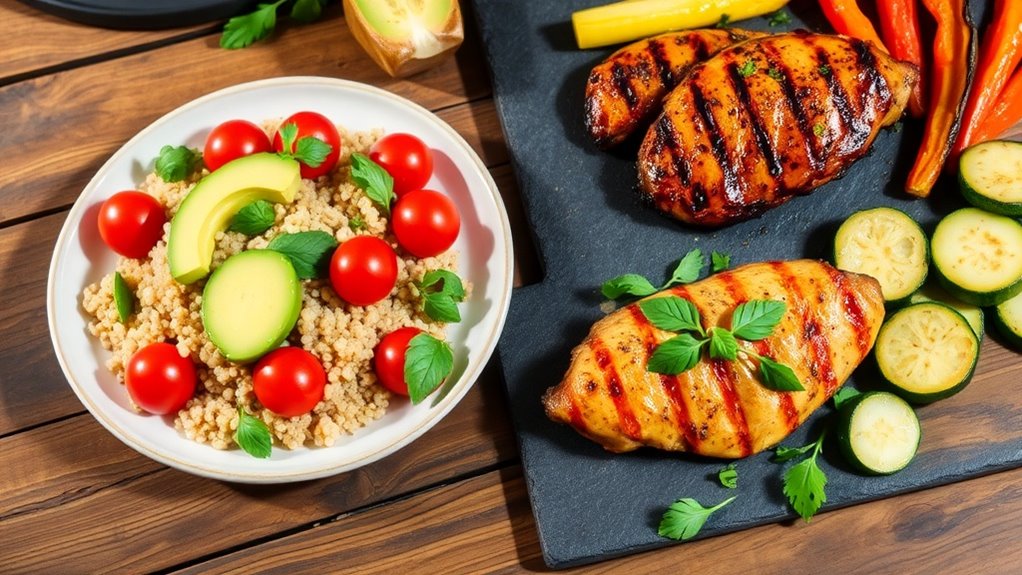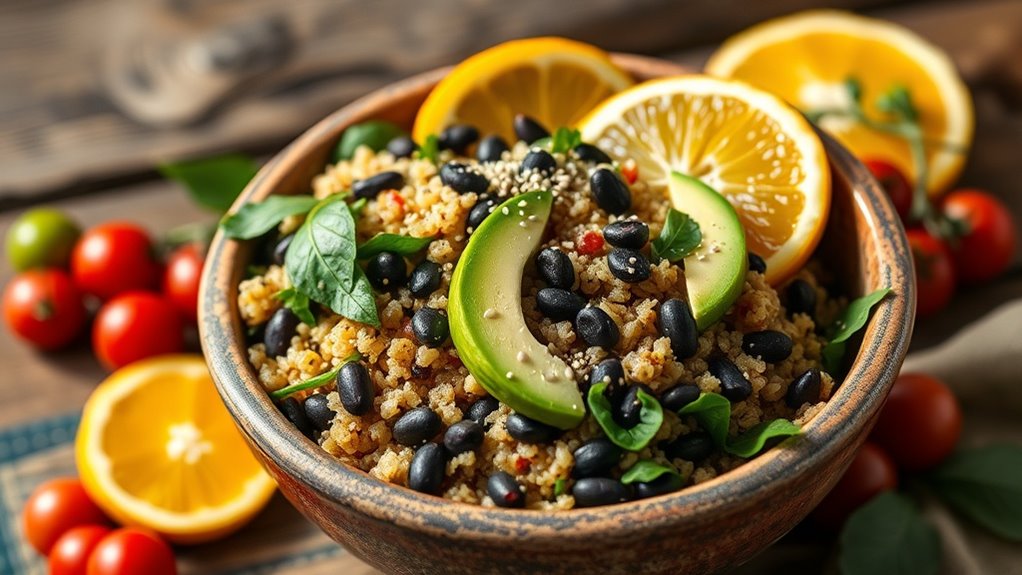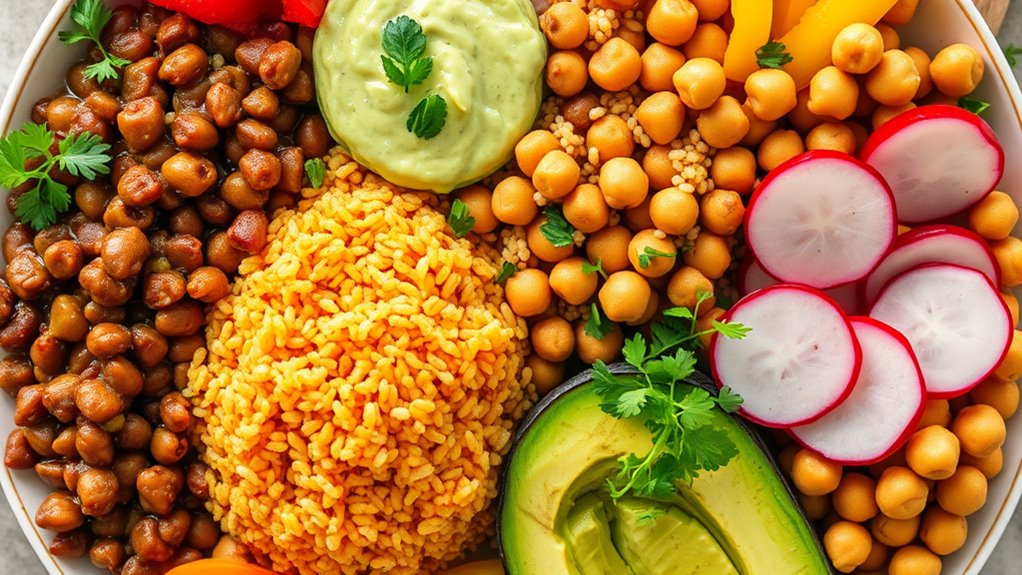Plant-Based Protein Options You Won’t Believe Exist!
You won’t believe the amazing plant-based protein options out there! Ancient grains like quinoa and farro pack a protein punch, while pulses such as lentils and chickpeas are versatile and delicious. Don’t forget about tiny seeds too—hemp, chia, and flaxseeds bring essential nutrients and richness to your meals. And guess what? Algae and seaweed are nutritional powerhouses, plus unconventional legumes and even edible insects offer sustainable protein sources. Stick around, and you’ll discover even more surprising choices!
Key Takeaways
- Ancient grains like quinoa, farro, and amaranth are complete protein sources, providing essential amino acids and nutrients for overall health.
- Pulses such as lentils and chickpeas are versatile, high-protein options that promote digestion and stable blood sugar levels.
- Nutrient-rich seeds, including hemp, chia, and flaxseeds, enhance dishes while contributing healthy fats and antioxidants to a plant-based diet.
- Algae and seaweed, especially spirulina, offer sustainable protein sources packed with essential amino acids and beneficial nutrients like omega-3 fatty acids.
- Unconventional legumes and edible insects, rich in protein, are eco-friendly alternatives that require fewer resources than traditional livestock for sustainable nutrition.
Ancient Grains: The Protein Powerhouses
As you explore plant-based protein options, you’ll find that ancient grains aren’t just relics of the past; they’re nutritional powerhouses packed with protein.
Grains like quinoa, farro, and amaranth offer unbelievable proteins that elevate your meals. Quinoa stands out as a complete protein, containing all nine essential amino acids, while farro provides fiber and nutrients that support muscle growth.
Incorporating amaranth into your diet can also boost your protein intake considerably. These grains don’t just enhance your plate; they deliver the sustenance your body craves. In fact, plant-based protein sources are often rich in essential nutrients that support overall health and well-being.
As you master plant-based eating, knowing how to utilize ancient grains creatively will elevate your culinary skills and nutritional knowledge. Transform your meals with these versatile options and reveal the incredible benefits of ancient grains.
Pulses: Surprising Sources of Strength
Pulses, such as lentils, chickpeas, and black beans, are packed with protein and can easily transform your plant-based meals.
These legumes aren’t just nutrient-dense but also versatile, allowing you to create hearty soups, salads, and mains that satisfy your cravings.
With a remarkable protein content – often around 15-20 grams per cooked cup – they’re perfect for muscle recovery and growth.
Plus, their high fiber and low glycemic index make them excellent for digestion and blood sugar control.
Experiment with different varieties in your dishes; their unique textures and flavors can elevate even simple recipes. Additionally, pulses are unique plant-based sources that provide essential nutrients beyond just protein, enhancing your overall diet.
Seed Superstars: Tiny Yet Mighty Proteins
When you think of protein, seeds mightn’t be the first thing that comes to mind, but they pack a powerful punch. Loaded with essential nutrients, these tiny superstars can easily be added to your meals for a healthy boost. From salads to smoothies, their versatility makes them a fantastic addition to any diet. Additionally, many seeds are rich in omega-3 fatty acids, which are essential for heart health.
Nutritional Powerhouses
Although you might overlook them due to their small size, seeds pack a powerful nutritional punch that can greatly enhance your plant-based protein intake.
These tiny treasures are rich in essential nutrients, providing a robust combination of macronutrients and micronutrients. For instance, hemp seeds offer a perfect balance of omega-3 and omega-6 fatty acids alongside high-quality protein, helping you maintain ideal health.
Chia seeds are another powerhouse, delivering fiber, antioxidants, and minerals that support digestion and overall wellness.
Flaxseeds, too, bring a wealth of benefits with lignans that can boost heart health.
Incorporating a variety of seeds into your diet not only enriches your protein sources but also fortifies your nutritional profile, setting you on a path to mastery in plant-based nutrition.
Versatile Culinary Uses
Seeds aren’t just nutritional powerhouses; they also bring immense versatility to your kitchen. With a little creativity, you can transform these tiny gems into culinary delights.
Think sunflower seeds as a crunchy topping for salads or pumpkin seeds blended into a creamy pesto. Chia seeds can thicken your smoothies or become a base for a decadent pudding. Flax seeds work wonders as an egg substitute in baking, adding moisture and nutrition.
Toss hemp seeds into your granola for an extra protein boost, or sprinkle sesame seeds over stir-fries for a nutty flavor. The options are endless.
Embrace seeds, and elevate every dish with unique textures and tastes while effortlessly packing in plant-based protein!
Underwater Gems: Algae and Seaweed
When you think of plant-based proteins, don’t overlook the incredible potential of algae and seaweed. These underwater gems pack a powerful nutritional punch and can fit seamlessly into various dishes. Plus, choosing them supports sustainable food sources that benefit our planet. Furthermore, algae and seaweed are rich in nutritional benefits, making them an exceptional option for enhancing your diet.
Nutritional Powerhouses Unveiled
As you explore plant-based protein options, don’t overlook the nutritional powerhouses found beneath the waves—algae and seaweed. Packed with essential amino acids, these marine marvels offer a protein profile that rivals traditional sources.
Spirulina, a blue-green algae, boasts high protein content alongside omega-3 fatty acids, iron, and antioxidants. Meanwhile, nori and dulse provide not just protein, but also vitamins like B12 and numerous minerals vital for overall health.
The bioactive compounds in these underwater gems can support immune function, enhance gut health, and provide anti-inflammatory benefits.
Integrating algae and seaweed into your diet isn’t just about protein; it’s about harnessing a wealth of nutrients that elevate your wellness journey. Embrace these marine options for holistic nourishment.
Culinary Versatility Explored
Algae and seaweed aren’t just nutritional powerhouses; they’re also incredibly versatile in the kitchen. You can incorporate these oceanic gems into a wide array of dishes, from salads to soups.
Try using nori sheets to create sushi or crumble dulse flakes as a savory seasoning for vegetables. Seaweed salad, with its delightful texture, can be a revitalizing starter. You can even blend spirulina into smoothies for an energy boost.
When crafting broths, kelp adds depth and umami flavor, elevating your culinary creations. Use algae powders for nutritional enhancements in baked goods or savory sauces.
Master these ingredients, and you’ll open up a world of flavor, nutrition, and creativity like never before!
Sustainable Food Source Benefits
Though often overlooked, algae and seaweed offer remarkable benefits as sustainable food sources. These underwater gems require minimal land, water, and energy to cultivate, making them eco-friendly alternatives to traditional crops. They absorb carbon dioxide and enrich marine ecosystems, promoting biodiversity.
Rich in essential nutrients, such as omega-3 fatty acids, vitamins, and minerals, they support overall health while providing a potent protein source. Additionally, their cultivation can help combat ocean acidification and mitigate climate change effects.
Unconventional Legumes: Beyond Beans
While beans often steal the spotlight in discussions about plant-based protein sources, there’s a diverse range of unconventional legumes that deserve your attention.
Consider lentils, which pack a powerful protein punch and come in various colors, each with unique culinary applications.
Chickpeas, another powerhouse, can be transformed into creamy hummus or crunchy snacks, making them incredibly versatile.
Then there are black-eyed peas, often overlooked, but rich in both protein and fiber, perfect for stews or salads.
Don’t forget pigeon peas, a staple in many cultures, boasting a unique flavor profile.
In addition to these popular options, you’ll find that unconventional legumes can be prepared in various creative ways to enhance your meals.
Experimenting with these legumes not only enhances your dishes but elevates your nutritional intake.
Edible Insects: A Protein-Rich Future
Have you ever considered the potential of edible insects as a sustainable protein source? These little powerhouses pack a nutritional punch, offering high protein content, essential amino acids, and healthy fats.
With over 2 billion people already enjoying insects as part of their diets, it’s time to embrace this innovative option. They require considerably less land, water, and feed compared to traditional livestock, making them an eco-friendly choice.
Insects like crickets and mealworms can be easily incorporated into protein bars, snacks, or baking mixes, transforming how you fuel your body.
By exploring the diverse culinary possibilities of insects, you can’t only enhance your meals but also contribute to a more sustainable food system.
Why not plunge into this exciting protein frontier?
Frequently Asked Questions
Are Plant-Based Proteins as Effective for Muscle Building as Animal Proteins?
Yes, plant-based proteins can be just as effective for muscle building as animal proteins. They provide essential amino acids, promote recovery, and, with proper combinations, support your strength training goals. Your diet can thrive on plants!
How Do Plant-Based Protein Options Compare in Taste and Texture?
When comparing plant-based protein options, you’ll find diverse flavors and textures. Some mimic meat’s savory taste, while others offer unique, earthy notes. Experimenting with different types can elevate your meals and satisfy your palate effectively.
Can I Get Enough Protein From a Fully Plant-Based Diet?
You can absolutely get enough protein from a fully plant-based diet; studies show that vegetarians often meet their protein needs. With careful planning and diverse foods, you’ll master your protein intake while enjoying delicious meals.
What Are the Benefits of Combining Different Plant Protein Sources?
Combining different plant protein sources enhances your amino acid profile, ensuring you get all essential nutrients. You boost digestibility and absorption too, maximizing your muscle repair and overall health benefits. Diversify your meals for ideal results!
Are There Any Allergies Associated With Plant-Based Protein Sources?
Yes, some people can have allergies to certain plant-based proteins, like soy or legumes. If you’re adopting a plant-based diet, it’s smart to monitor your reactions and consult a professional if needed.





